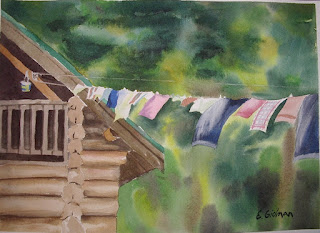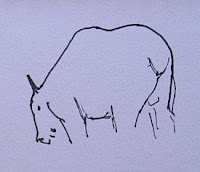 |
| watercolour - 'Evening in the Desert' |
Creating a Graduated Wash:
This small watercolour was created on a demo piece showing a graduated wash. The paper was orientated 180 degrees from what is shown here, and tilted about at about a 30 degree angle. Although numbers make the process sound technical, it is easy to do.
Mix up enough paint in one colour to be able to cover your entire paper. Starting at the top, using a wide brush, in one even stroke lay a strip of colour. Quickly add a bit of water to the paint mix and repeat the painting process slightly overlapping the second brush stroke with the bottom of the first brush stroke. With each successive brush stroke make the paint mix increasingly more watery and less paint.
When the paper is completely covered lay the paper flat to dry. With a tissue, wipe up any excess paint at the edges of the paper. The key to retaining the luminosity is to avoid over brushing. If you have to add more paint as you go across the page, do so but avoid multiple brush strokes going over the same area.
After the paper is thoroughly dried you can add a silhouetted image on top using a darker colour. Here I used the same hue, only darker, making this an analogous colour scheme. In this class, Margie painted this same image but chose to paint a burnt sienna colour over an light blue-green background using a near complementary colour scheme. It was a good choice too.
















































